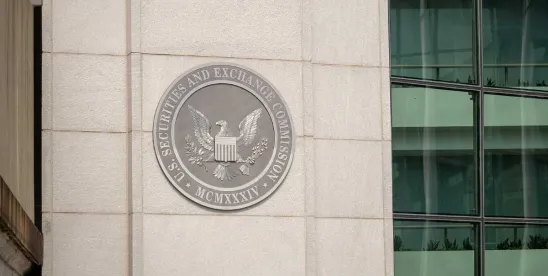Highlights
- The SEC issued new guidance on how an issuer wishing to engage in general solicitation under Rule 506(c) may satisfy the rule’s accredited investor verification requirement
- The guidance clarifies that in appropriate circumstances, a minimum investment amount coupled with the receipt of investor representations may constitute reasonable verification steps
- Corporate issuers and private fund sponsors now have a clearer path to engage in broad outreach to prospective investors without imperiling an offering’s exemption from Securities Act registration
On March 12, 2025, the staff of the Securities and Exchange Commission (SEC) Division of Corporation Finance issued new guidance on the accredited investor verification steps an issuer must take in order to make an unregistered offering in reliance on Rule 506(c) under the Securities Act. The guidance indicates that issuers may fulfill the Rule 506(c) accredited investor verification requirement by imposing relatively high minimum investment requirements and obtaining related purchaser representations.
The SEC staff thus has opened a clearer path for issuers – including both operating companies and private funds – to engage in broad outreach to prospective investors without endangering an offering’s exemption from Securities Act registration.
Background
Section 4(a)(2) of the Securities Act exempts from registration “transactions by an issuer not involving any public offering.” Regulation D is a safe harbor under Section 4(a)(2), compliance with which ensures that an offering satisfies the statutory exemption. For most private issuers, the key traditional component of Regulation D has been Rule 506(b). That rule permits unregistered offerings of any size to accredited investors (and a limited number of non-accredited investors), on the condition that, among other things, the issuer refrains from “general solicitation” in connection with the offering.
In the JOBS Act of 2012, Congress directed the SEC to expand Regulation D to permit general solicitation in certain unregistered offerings. The SEC did that by adopting Rule 506(c). Rule 506(c) states that an issuer may use general solicitation when conducting an unregistered offering of any size, provided that all purchasers in the offering are accredited investors and the issuer takes “reasonable steps to verify” each purchaser’s accredited investor status.
Since the rule’s adoption in 2013, issuers have not engaged in Rule 506(c) offerings to the extent many observers had initially predicted, primarily because issuers have viewed the accredited investor verification requirement as unwieldy in practice. While Rule 506(c)(2)(ii) sets forth a list of “non-exclusive, non-mandatory” verification methods that are deemed sufficient, issuers generally have seen these as burdensome to use and uncomfortably intrusive for investors.
At the same time, issuers have been concerned that relying on the principles-based verification approach noted in the 2013 adopting release might not provide unambiguous grounds to conclude that Rule 506(c) has been satisfied, in part because the release makes clear that a mere representation by a prospective purchaser as to its accredited investor status generally would not fulfill the verification requirement.
Private issuers, including private fund sponsors, therefore have largely foregone the allure of general solicitation and continued their traditional reliance on Rule 506(b).
New SEC Guidance
The Division of Corporation Finance staff now has issued fresh guidance concerning what can constitute “reasonable steps to verify” a purchaser’s accredited investor status for purposes of Rule 506(c). The guidance, issued on March 12, takes the form of new Compliance and Disclosure Interpretations (CDI) 256.35 and 256.36, as well as a related no-action letter addressed to Latham & Watkins LLP. The staff’s initiative has the potential to revive the appeal of Rule 506(c).
Minimum Investment Amount Is a Relevant Verification Factor
CDI 256.35 advises that if an issuer does not take any of the non-exclusive, non-mandatory accredited investor verification steps outlined in Rule 506(c)(2)(ii), it can apply a reasonableness standard directly to the specific facts and circumstances of the offering and its investors. Reprising the principles expressed in the 2013 adopting release, the guidance notes that in determining what constitute reasonable verification steps, the issuer should consider factors such as the nature of the purchaser and the type of accredited investor it claims to be; the amount and type of information that the issuer has about the purchaser; and the nature and terms of the offering, including any minimum investment amount.
High Minimum Investment Amount Plus Purchaser Representations May Equal Reasonable Steps to Verify
CDI 256.36 and the no-action letter address in more detail the possible significance of a minimum investment amount in the accredited investor verification context. The guidance here advises that, depending on the facts and circumstances, an issuer may be able to conclude that it has taken reasonable steps to verify purchasers’ accredited investor status when the offering “requires a high minimum investment amount.” In amplification of that thought, the no-action letter states that an issuer generally could conclude that it has taken reasonable steps to verify a purchaser’s accredited investor status if:
- the offering requires a minimum investment of $200,000 for a natural person or $1,000,000 for an entity
- the issuer obtains written representations that:
- the purchaser is an accredited investor
- the purchaser’s minimum investment amount is not financed in whole or in part by any third party for the specific purpose of making the particular investment in the issuer
- the issuer has no actual knowledge of any facts indicating that the foregoing purchaser representations are not true
The idea that a minimum investment amount can be a key factor in the analysis of reasonable verification steps is not completely new. As noted, the Rule 506(c) adopting release raised this concept in general terms. The new guidance, though, is more specific and thus may inspire more confidence on the part of issuers who decide to follow it. In particular, the staff’s position now essentially permits a form of “self-certification” of accredited investor status in Rule 506(c) offerings akin to the procedure on which issuers have long relied in traditional Rule 506(b) accredited investor offerings. This is a welcome development and should reduce uncertainty for issuers conducting or considering generally solicited offerings.
Takeaways
The SEC staff now may have reinvigorated the original promise of Rule 506(c). By providing a clear explanation of how minimum investment amounts and related investor representations may satisfy the accredited investor verification requirement, the guidance offers a means of using Rule 506(c) that is more straightforward and less intrusive than issuers previously have seen the rule to be. At least for well-established corporations and private fund sponsors (for which imposing significant minimum investment amounts is typically not a problem), new and fruitful forms of offering-related publicity now may become a practical option.
Of course, an issuer that decides to engage in general solicitation under Rule 506(c) must take care that its public statements are truthful, properly vetted, and consistent with its offering materials, in order to avoid anti-fraud issues under Rule 10b-5 or state law. In addition, where an offering also is being made outside the United States, the issuer must ensure that any public marketing done in reliance on Rule 506(c) does not conflict with relevant foreign regulations.






 />i
/>i
